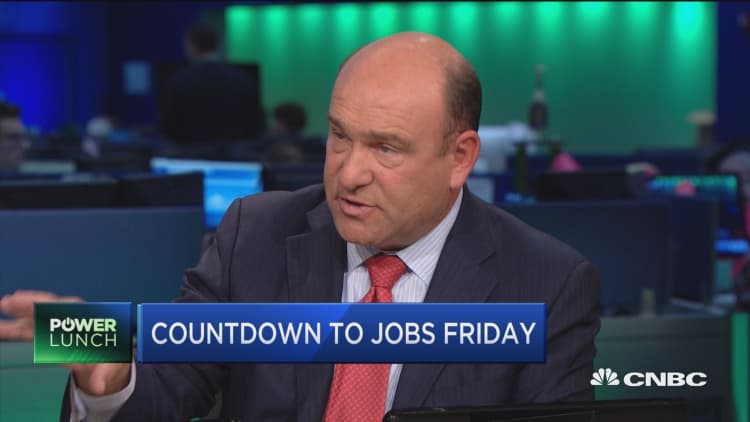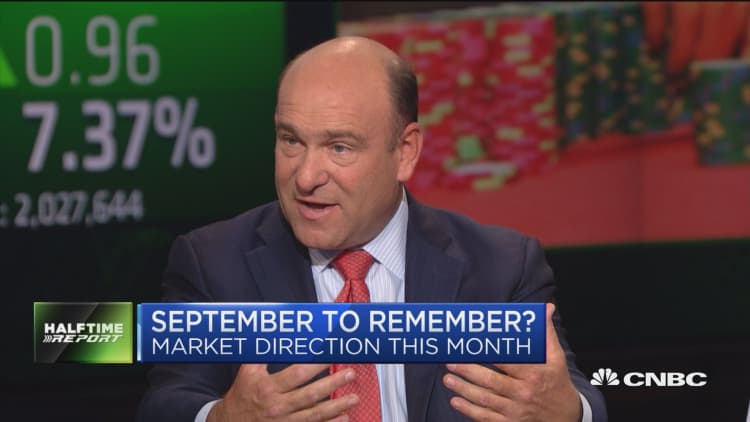


U.S. stocks closed mostly flat Thursday as investors digested a slew of economic data ahead of Friday's key jobs report.
The Dow Jones industrial average closed about 15 points higher, after briefly falling more than 100 points. The S&P 500 fell less than a point, after being dragged by a 1 percent fall in financials. Utilities were the greatest laggards at the close. The Nasdaq composite outperformed, gaining about 0.3 percent.
Banks stocks fell, with the SPDR S&P Bank ETF (KBE) and the SPDR S&P Regional Banking ETF (KRE) dropping around half a percent.
"It's a confluence of two things. First, the Dow hit its 50-day moving average and that's being defended, and there isn't a lot of strong selling," said Adam Sarhan, CEO at Sarhan Capital.
The ISM manufacturing index for August came in at 49.4, the weakest read since January. The Markit manufacturing PMI index, meanwhile, came in at 52.0. A number above 50 reflects expansion, while a number below 50 shows contraction.
"The ISM was a very bad number," said Peter Cardillo, chief market economist at First Standard Financial. "It shows manufacturing is back into recession and that clears way for the Fed to hold in September."
Second-quarter productivity dropped at a 0.6 percent annualized rate, while weekly jobless claims came in at 263,000, slightly better than expectations.
"With initial claims at 263,000, that was very much expected," said Thomas Wilson, senior investment manager at Brinker Capital. "Then the productivity number that came in was not as positive."
"There's a lack of volume because a lot of folks are out on vacation, but people are also waiting for Friday's jobs report," said Katie Stockton, chief technical strategist at BTIG.
The August employment report is due for release Friday at 8:30 a.m. ET. Economists polled by Reuters forecast the economy added 180,000 jobs in August.
"If there's one economic report that's going to move the needle, it's this one," Sarhan said.
Investors will closely read the report, looking for clues about whether the Federal Reserve will raise interest rates in September. Market expectations for a September rate hike were at 30 percent Thursday morning, according to the CME Group's FedWatch tool.
"Of all these wait-and-see weeks we've had ... this is the most imperative," said Art Hogan, chief market strategist at Wunderlich Securities. "I don't expect any players to make any big decisions in front of the report."
Thursday was the first trading day in September, which has historically been a volatile month for stocks. The S&P has recorded a move of at least 1 percent — in either direction — every September since 2006.
"There's a lot going on in September and that's going to set the tone for the rest of the year," said Casey Clark, vice president of investment strategy at Glenmede, noting September will see a jobs report, a European Central Bank meeting, a Fed meeting and a U.S. presidential debate, among other events.
"The economy and the markets are strong enough to handle a rate hike this year. Much like last year, this is going to draw a lot of attention from market participants ... but we think it will be a relative non-event," Clark said.
August concluded with the S&P slipping 0.12 percent, snapping a five-month winning streak.
"It was essentially the first down month for the S&P since the February low," BTIG's Stockton said. "It reflects a pause in the market."
"You could walk away thinking not much happened in August, ... except for the sector rotation, which is good for the market," Wunderlich's Hogan said. "Inside a very quiet month, you had a rotation from the overbought into the oversold."
The financials sector led the way for the S&P in August, rising more than 3.5 percent.
But the S&P posted its fifth negative session in six on Wednesday. "The first level of importance is 2,135 as initial support and a former resistance level," Stockton said. She added that it's possible for the S&P to breach that level in the near term, but " there's still a lot of support below."
In oil markets, U.S. crude settled 3.45 percent lower at $43.16 a barrel, as supply glut worries resurfaced after Wednesday's inventories report from the Energy Information Administration.
U.S. Treasurys rose Thursday, with the two-year note yield near 0.78 percent and the benchmark 10-year yield around 1.57 percent. The dollar fell against a basket of currencies, with the euro near $1.12 and the yen around 103.20.
Major U.S. Indexes
The Dow Jones industrial average rose 18.42 points, or 0.1 percent, to close at 18,419.30, with Wal-Mart leading advancers and American Express the top decliner.
The fell 0.09 points, with utilities leading four sectors lower and information technology the top riser.
The Nasdaq gained 13.99 points, or 0.27 percent, to end at 5,227.21.
Decliners were a step ahead of advancers at the New York Stock Exchange, with an exchange volume of 817.29 million and a composite volume of 3.33 billion at the close.
The CBOE Volatility Index (VIX), widely considered the best gauge of fear in the market, traded higher, near 13.5.
Gold futures for December delivery settled $5.70 higher at $1,317.10 per ounce.
On tap this week:
*Planner subject to change.
Thursday
Earnings: Campbell Soup, Broadcom, Cooper Cos, Lululemon Athletica, Verifone, Lands End, Vera Bradley, Joy Global, Ciena, Smith & Wesson
Friday
8:30 a.m. August Employment report
8:30 a.m. U.S. trade deficit
10 a.m. Factory orders
1 p.m. Richmond Fed President Jeffrey Lacker


